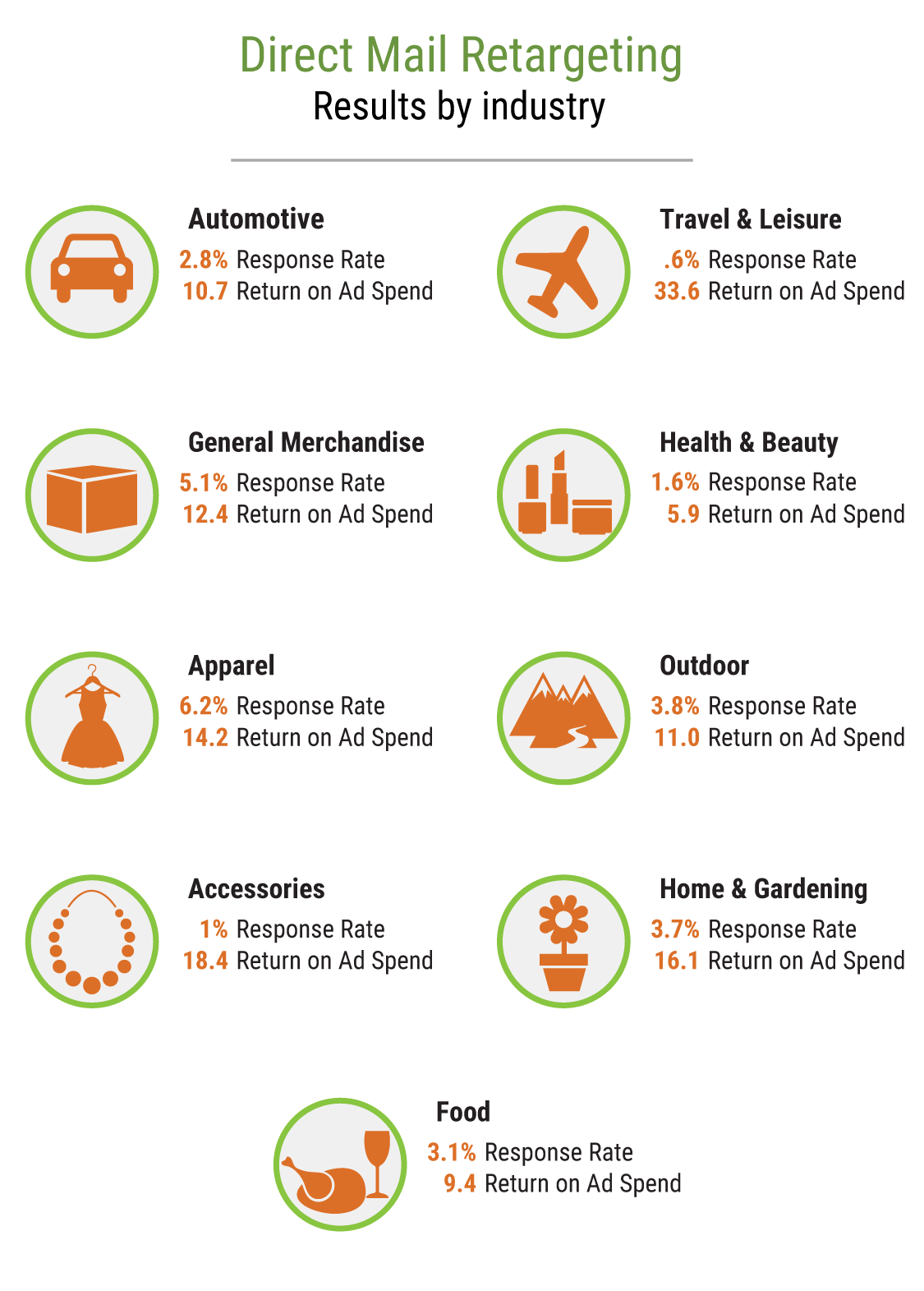Many industries are taking advantage of direct mail for transactional and ecommerce retargeting. This is thanks to its effectiveness in increasing return on ad spend (ROAS) and driving down the cost of acquisition. In this article, see actual direct mail retargeting results and case studies, and why and how it achieves such impressive results.
ROAS: direct mail retargeting results by industry
We have broken out a 12-month rolling average of direct mail retargeting results across several verticals commonly using ecommerce retargeting. But these aren’t the only industries that can achieve superior results; non-profit, healthcare, insurance, and financial services are a few others. See our case studies for examples!

What’s behind the effectiveness of direct mail retargeting?
There are several key factors that put direct mail retargeting in another category when it comes to retargeting results.
1. Sophisticated targeting
Direct mail retargeting triggers a personalized mailer to an individual based on intent signals. Specifically, after online browse or search activity, brick and mortar shopping behavior, or an abandoned online cart, the mail piece reminds the consumer of what they were interested in. There are direct mail retargeting strategies that, among other things, examine how specific you personalize the imagery and messaging. The goal is to find the sweet spot of specificity, and this can vary by topic.
2. Timeliness
Retargeting strategies consider the buying funnel for the product or service you are marketing. Timeliness is key to capturing the purchase while the consumer is in buying mode. The direct mail piece is triggered by the online activity or mobile intent signal, created, and mailed within 48 hours.
3. Paper
Studies continue to show that memory and comprehension are better when one reads something on paper versus on a screen. Research has also found that direct mail stimulates 29% higher brand recall than digital advertising, and elicits 39% more time spent with campaign elements than single-media campaigns. The Abandoned Cart Reactivation Study shows that when retargeted direct mail is added to retargeted email, response rate is 114% higher, with more than two times the sales.
Add to that the digital fatigue consumers are experiencing in 2021. An March 2022 survey of 1,000 consumers and 400 B2C marketers resulted in 75% of consumers reporting they are overwhelmed by the number of digital ads they see daily. 88% of marketers surveyed agree their customers are overwhelmed by the increased use of digital marketing channels since the start of COVID-19¹.
4. Discounts on the delivery mechanism
No other form of retargeting has opportunities to save on the cost of delivery. You will not find discounts or promotions on your display network or social advertising cost per click. Meanwhile, these costs continue to rise. But on top of the high returns on ad spend noted above, the USPS offers 5% off postage for retargeting July through November. For details, see the bottom of this article.
What direct mail retargeting ROAS should I aim for?
Marketers are all-too-familiar with the barriers and limitations their brand’s particular situation has on their marketing and advertising results. Once you understand your own context and benchmarks, you can apply that here. Below are the most common factors that affect return on ad spend for direct mail retargeting.
Seasonality
The numbers in the above infographic are for a rolling 12 months. Yet, seasonality greatly affects the results of certain industries. For example, if your niche is Gardening, expect return on ad spend for your three-month peak period to be higher.
Variances in Average Order Value
Considered purchases see a higher return on ad spend. This is likely no surprise, as this is a pattern for several marketing tactics, such as with search engine optimization. In general, the higher the order value, the more of a considered purchase a product or service is. This is why response rates can vary dramatically across industries, but that doesn’t indicate the effectiveness of the direct mail retargeting tactic.
Note that average order values vary significantly across industry, and greatly impact return on ad spend.
Note, it is highly likely you’ll see an increase in average order value with direct mail retargeting, compared to without it. This is a common phenomenon whether used omnichannel or as the sole channel. This may be because direct mail is a more trusted channel than digital channels, and therefore a key element when marketing higher-end and considered purchases. In a recent omnichannel test where direct mail retargeting (over 100,000 pieces) was paired with digital retargeting ads, the group that received both print and digital ads had an average order value 48% higher than the group that only received the digital ads.
The best way to set expectations for a particular campaign and to ensure you are maximizing ROAS is to test. Work with experts to discuss your overall goals and strategy, and to design a test plan. Consider your format, as well. In the majority of cases, a 4.25″ x 6″ postcard is optimal. But there are a few exceptions, and with the preferred postcard rate being extended to 6″ x 9″ postcards, it may be worth a test.
Case Studies
Let’s look at a few examples to compare specific approaches and see how they turned out.
Drive down the cost of acquisition
A home improvement broker and installation company needed to find a new scalable channel to acquire home renovation customers and lower their acquisition cost. With a postcard retargeting program personalized at the product category level, the creating an optimized program they could scale.
30:1 ROAS
Scoring for higher response
Direct mail was already a key part of the marketing strategy for a leader in luxury travel. They were looking for ways to increase response rate and improve ROAS. With data modeling, website visitors were scored for those most likely to convert. They then received timely and highly individualized direct mail.
2% increase in response rate
60x ROAS
Reach otherwise unreachable prospects
A home furnishings and accessories company struggled with sources of new customers. They needed to drive greater demand from the consumers visiting their website. By mailing catalogs to highly qualified website visitors who browsed their site but did not purchase, they improved their results over traditional list sources.
35% more productive list source
95% unique to traditional sources
Postage Savings
Take Advantage of Postage Savings
Now through November 30, the USPS is offering a 5% postage discount on your First Class Mail postcard retargeting campaign. Contact SG360° to find out how our programmatic, personalized postcard production can automate your retargeting efforts.
SG360° has the expertise to help you apply and qualify to save on postage all year. Check out the unique promo opportunities that are available for 2023.
¹2022. The Future of Direct Mail 2022. SG360°.
For more information on how direct mail retargeting can work for you, reach out to us:

